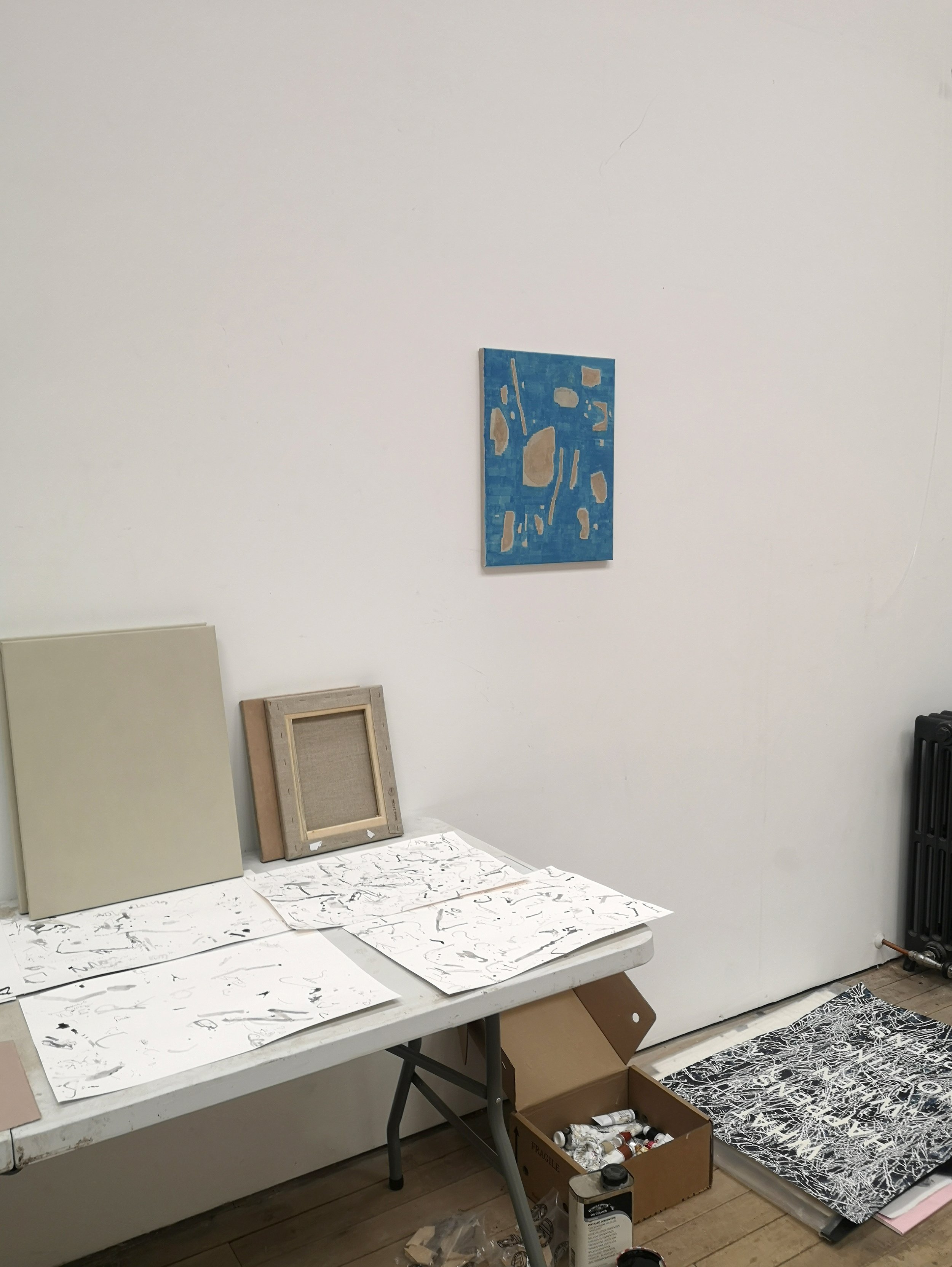no through road (cerulean blue); oil on linen, each 45 x 35 cm; 2022. Installed in the Squash Court Studio, Marchmont House, Scottish Borders
Six walks on the Marchmont estate
March 2022
1
Arrive and unpack, laying out my temporary studio across two foldout tables, and head out. Notebook in my bag, sky overcast. Look for a patch of ground sheltered from the rain.
After a few minutes the path falls away quite suddenly: a steep slope of hawthorns, lower limbs furred over with moss, almost a thicket. This ribbon of trees might once have been a hedge – a man-formed boundary now finding its own shape. Branches drip with turquoise lichens, each branch as much a weight of lichen as of wood.
The sense of a place undisturbed by footfall, attested by these paper-light stalks of last summer's self-heal.
In the cover of the trees there's enough shade and damp to break the turf’s grip, and multitudes of tiny leaves are coming through –
barren strawberry – missing the tooth at its tip
celandine hearts
primroses’ puckered beginnings
ground ivy, deep maroon where the leaves emerge
creeping buttercup (won’t be this vulnerable for long)
The ground so soft that falling feathers pierce the earth like darts.
Noting the wild plants coming up might be the simplest way of proving you are here.
2
More lichens: a hieroglyph picked out in acid yellow
I’m filming a small patch of ground, a metre or so across. Nothing to see here: dirt, shreds of bark, semi-rotted leaf fragments, bits of twig. What happens when nothing happens? How does the eye latch on, find a tether, relay its place? I track the damp earth with my phone at arm’s length, accumulate five minutes of hovering footage I’ll use in the studio later, relaying as much as anything my own uneven breath.
Getting up from an awkward numb crouch I have to put a hand under each knee to lift the leg, replant the foot in the purple soil. They might as well be lower limbs of trees, blunt-ended serifs.
3
I spend the last hour of the day drawing a great shroud of dead cleavers, which hangs over the hedgerow like lace. When the rain starts its drops blur my ink lines into discs exactly the size of their seeds.
A drawing, because of its openness, always invites something to come before or after it.
I need to keep some of the same openness in the surface of these paintings.
4
For man … reality is not a given: it has to be continually sought out, held – I am tempted to say, salvaged … Events are always to hand. But the coherence of these events, which is what one means by reality – is an imaginative construction.
John Berger [1]
Light slides off the lines of spiders’ webs, flashing between the stems of last year’s nettles.
5
Reading is something for your eyes to do
Tracking words along a line is a way of looking without doing
But reading is also an instinct to look for meaning
If, in painting, there is a suggestion of movement – which is an inevitable consequence of a horizontal brushstroke at its simplest and most open – then this somehow makes the stillness of the image more still, more emphasised. The image hovers but is quiet.
Last week I ordered three tubes of cerulean blue, each made by a different manufacturer of artists’ pigments. I made swatches of each using the paint neat from the tube, then wetted with turpentine, then whitened with titanium. The first cerulean is innocent, buttery, but with an uneasy translucency. The second takes a dimmer view, slanting towards grey. The third is uncannily bright, but too sure of itself, undimished by dilution or whitening and unexpectedly opaque. All bear the label ‘cerulean’.
Blue is an opinion, like everything else. None of the three is quite the blue I had in mind.
If I came here again the colour I’d reach for is the oxide or venetian red, the red of the earth exposed by trees uprooted in the recent storm.
6
Many trees down. In the woods flattened conifers criss-cross the ground. Among the debris, opposite-leaved golden saxifrage and dog’s mercury are pushing a way through. These are ancient woodland vascular plants – their proliferation signals the presence of woodland here for centuries.
Wanting too much to get work done, to get it out of my head and up on the wall, can stiffen everything. Too much control today in the paint surface, a tightness in the blocking in of the outlines. Heading out to draw makes a break; the same lines and shapes leap out of the grass but they have nothing to do with me.
Later in the studio I lay out my vocabulary across the floor, a series of shapes that has accumulated over years of drawings made looking at the ground (those bits of twig, leaf fragments, scraps of bark) as well as studying letterforms, in particular the weak points of serifs, the bits that might get chipped off. These shapes feel nothing-y, almost non-shapes, and they are, but they are also oddly easy to do badly. A lot of them get discarded.
When they assemble onto the surface of the canvas, there is a lot of shifting around, nudging, re-drawing to get them to feel right, in their relation to each other and to the edges of the image. I’m searching for a hover point – where elements are held in provisional balance, but with the sense that they might just as well have been otherwise.
The visible exists because it has already been seen. [2]
[1]&[2] from John Berger: And our faces, my heart, brief as photos, Bloomsbury, London; 2005
This work was during a residency at Marchmont House, Spring 2022. Thanks to Marchmont Makers Foundation, Berwick Creative Guild and Charlie Poulson.
The Old Squash Court studio, Marchmont House











